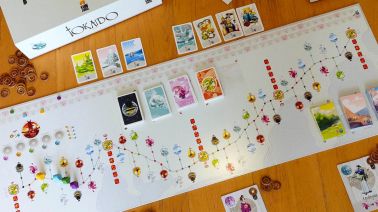Game Design in Real Life: Playing With Incentives
Incentives are one of the driving forces that shape human behavior in all areas. Whether it be business, government, or game design, learning to use incentives properly can be vitally important, and using them wrong can have disastrous consequences.

The following is a reproduction, and has been modified for this site. The original article, and many more, can be found at RemptonGames.com
Why is education important? Aside from the inherent joy of learning and the desire to constantly improve yourself and enrich your life, the answer most people would probably give is that you need education to get a job. But why do you need a job? Why, to earn money of course!
Why do you need money? To buy things, such as food, clothes, shelter and entertainment. Of course, you don’t need to work to get those things. You could just steal them! Stealing food from the grocery stores, clothes from clothing shops, etc. But most people don’t live that way. Why not?

Is it because they don’t look good in horizontal stripes?
There are two main reasons. The first is the fear of punishment – if you just stole everything you needed, chances are you will eventually get caught and punished with jail-time or fines at the very least. The second reason is an understanding that society would not work if everybody behaved this way, and not wanting to contribute to the weakening of society.
These are all examples of incentives. Whether it is the promise of education helping you get a job or the fear of getting arrested preventing us from breaking the law, most things that people do can be understood in terms of the incentives that drive the behavior.
Why am I talking about this? What does it have to do with game design? Why am I asking you so many questions? I am simply trying to illustrate a point – nearly everything we do (or don’t do) is caused by one thing – incentives. Incentives are one of the primary forces in the world that guide behavior, and can be a very powerful tool in game design.
Inventive Incentives
Simply put, an incentive is anything that is designed to motivate or encourage somebody to behave a certain way. Incentives can be divided into a number of subcategories, and the type of incentive used can make a big difference in how people react. The two main areas that incentives differ are Positive vs Negative incentives and Intrinsic vs Extrinsic incentives.
First, lets look at positive and negative incentives. Put simply, a positive incentive is a reward for performing some action, while a negative incentive is a cost or punishment for performing an action. In general, if you want somebody to do something more often you should use a positive incentive to reward them for that action. If you give your dog a treat after you tell them to sit, they are more likely to obey that command in the future.
Similarly, if you want somebody to stop doing something (or do it less frequently) you would attach a negative incentive to that action. For example, if you want your co-worker to stop chewing with his mouth open you could squirt him in the face with a water gun every time you see him do that, which would incentivize him to stop.

Try it one more time Greg, I dare you
For extra incentive-y goodness you can always combine positive and negative incentives to form a “carrot and stick”. This doubles down on encouraging a particular behavior by not only rewarding that behavior when it is performed, but also providing costs or punishment when it is not. This combination can be very effective, and should only be used when extreme motivation is necessary.
An example of positive and negative incentives in the modern world can be found in the tax system. Without getting too political, taxes are often used as an incentive by governments to encourage or discourage particular behaviors. For example, if a government wants to discourage cigarette smoking they may add a negative incentive to that behavior by raising taxes.
In the same vein, governments can encourage certain behaviors, such as charitable giving, by associating a tax break with those behaviors.
However, as you may already be able to tell from my use of this example, incentives are not always used thoughtfully. Continuing with the tax example, while taxes are occasionally used for their value as incentives, they are often simply seen as a way to raise money without regard to the effect that a particular new tax might have on behavior. This is a mistake, and I believe more thought should be put into how new taxes or tax breaks could affect the behavior of the public.
The next way to distinguish incentives is between intrinsic and extrinsic incentives. Basically, this is a distinction based on the source of the incentive. An intrinsic incentive has an internal source, whereas an extrinsic incentive comes from some outside source.
Intrinsic incentives are generally not tangible – they are positive or negative feelings and emotions that can drive behavior. In a game the most obvious example of an intrinsic incentive is fun – you perform actions in the game because you enjoy them.
Extrinsic incentives, on the other hand, tend to be more tangible. Things like money, items and services can be provided as a form of extrinsic incentive. In a game, an example of an extrinsic incentive would be providing the player with Victory Points, currency, or anything else that could improve their chances of winning.

Obviously nobody would ever take advantage of the tax system, but its still worth thinking about
The Most Important Rules of Incentives
Rule #1 – whenever there is an incentive to do something, some subset of the population will try to take advantage of it
This is something that must be planned for, otherwise you will be caught off guard. A great example of this comes from a promotion by PepsiCo known as Pepsi Stuff from the mid 1990s. Under this promotion people could earn Pepsi Points by buying various Pepsi products, and these points could then be traded in for various prizes. While most of the prizes were relatively normal items such as t-shirts and sunglasses, one commercial showed a Harrier Jet as a prize for 7,000,000 Pepsi Points.
Including the jet as a prize was, of course, intended as a joke, and Pepsi thought that there was no chance of anybody actually collecting 7 million points. However, they had forgotten the first rule of incentive systems. It turned out that you could purchase 7 million points for a mere $700,000 dollars (far below the manufacturing cost of around $25,000,000). This meant that anybody who was actually able to redeem this prize would make a huge profit so, unsurprisingly, somebody decided to go for it.
That person turned out to be a 21 year old business student named John Leonard. Leonard was able to raise the $700,000 from a number of wealthy investors, bought the points, and mailed the off to PepsiCo. Unfortunately, Pepsi refused to give Leonard his prize, which led to a legal battle which eventually ruled in Pepsi’s favor. Sadly, Leonard never got the jet that he rightfully deserved, but through this process everybody learned an important lesson. Pepsi continued to air the commercial, but changed the 7 million points to 700 million, which now meant that the cost of buying the points was more than the cost of the jet itself.

Rule #0 – Don’t offer a jet unless you can put your money where your mouth is
Rule #2 – People will do things they don’t want to do if the incentive is high enough
Put another way, a strong enough extrinsic incentive can and will overcome intrinsic incentives. This may seem obvious, and in fact one of the primary uses for incentives is getting people to do things that they don’t want to do. However, the important thing to keep in mind with this rule is that it doesn’t just apply to times when you are trying to get people to do things. Incentives can and will affect behavior even if that is not the goal, and therefore it is important think about what behaviors you may unwittingly be encouraging in your game.
For another real-life example, lets look at a promotion started by Hoover vacuums that coincidentally also took place in the early 90’s. Hoover’s marketing department made an offer to provide two free airline tickets with the purchase of any vacuum worth over 100 pounds. They believed that this would encourage people to buy the more expensive models, since it would seem like a more reasonable purchase with the tickets.
Unfortunately, that’s not how incentives work, as they soon learned. Before long hundreds of thousands of people had ordered cheap vacuums that they didn’t want, for the sole purpose of getting the much more valuable free tickets. This led to huge losses for the company – while they sold around 30 million pounds worth of vacuums, they ended up spending more than 50 million pounds on airline tickets.

Vacuums….airplane tickets…the connection couldn’t be more obvious
The fundamental mistake here is that Hoover believed that adding this additional incentive would NOT fundamentally change consumer behavior. They believed people would only buy vacuums if they needed them, but would be more willing to buy the more expensive models and less likely to go with a competitor.
The flaw in this logic is that changing behavior is literally the entire point of creating an incentive in the first place. You cannot add a new incentive and expect behavior not to change, you can only attempt to anticipate what kind of change will occur.
Incentive Tension
One interesting aspect of incentives is the tension that can occur when multiple incentives conflict with one another. In fact, this is the core of strategy in games. At any given time you have several options, and many of them will move you further towards your goal. However, in order to make one choice you have to miss out on others, and it is up to the player to decide what is the most valuable to them.
Therefore, when designing games it can sometimes be necessary to purposefully add conflicting incentives to add additional depth of strategy to the game. However, it is important not to overdo it, and finding the right balance for your particular game can be quite a difficult task.
To see why, lets consider a game that has no conflicting incentives. Generally this means that your game will only have a single goal, and a single path to achieve that goal. These games tend to be quite simple, and are played more for fun than strategy.
An example of this is Apples to Apples. The only thing the game encourages you to do is to pick the card that is most likely to be chosen. There is no tension or conflict among the incentives, which leads to a very simple and straightforward game without a lot of strategic depth.
On the other extreme you have “point salad games” such as Tokaido, where there is such constant tension between different incentives that it becomes difficult to even make an informed choice about what to do. Pretty much any action you take will give you victory points, and when you are being pulled in all directions at once it is the same as having no direction at all.

Should I see a landscape or buy a souvenir? Does it matter?
Most games are going to find themselves somewhere in the middle of these two extremes. You want enough tension to force your player to make meaningful decisions, but not too much tension that makes it impossible for them to actually choose.
However, there is one area that you absolutely want to avoid designing tension, and that is between what your player WANTS to do and what they NEED to do to win. Basically, your players are going to be drawn to the most fun parts of your game – this is an intrinsic incentive. However, if those fun parts of the game are not necessary to win (or even counterproductive) this can lead to a very dangerous type of tension.
In this situation your player only has two choices, neither of which are very desirable. On the one hand they can take the path that leads to victory, but if this path isn’t fun it can lead to disappointment. On the other hand they can take the fun path, but this too can lead to disappointment if they never win.
This sort of tension is not good for your game, and if you encounter it in your game it probably means you need to adjust some things so that the fun path is also the path that leads to victory.
Until Next Time!
That is all I have for this week. If you enjoyed this article, check out the rest of the blog and subscribe on Twitter, Youtube, or here on WordPress so you will always know when I post a new article. If you didn’t, let me know what I can do better in the comments down below. And join me next week for my second video article, which you can help choose on Twitter!
Read more about:
BlogsAbout the Author(s)
You May Also Like







.jpeg?width=700&auto=webp&quality=80&disable=upscale)








